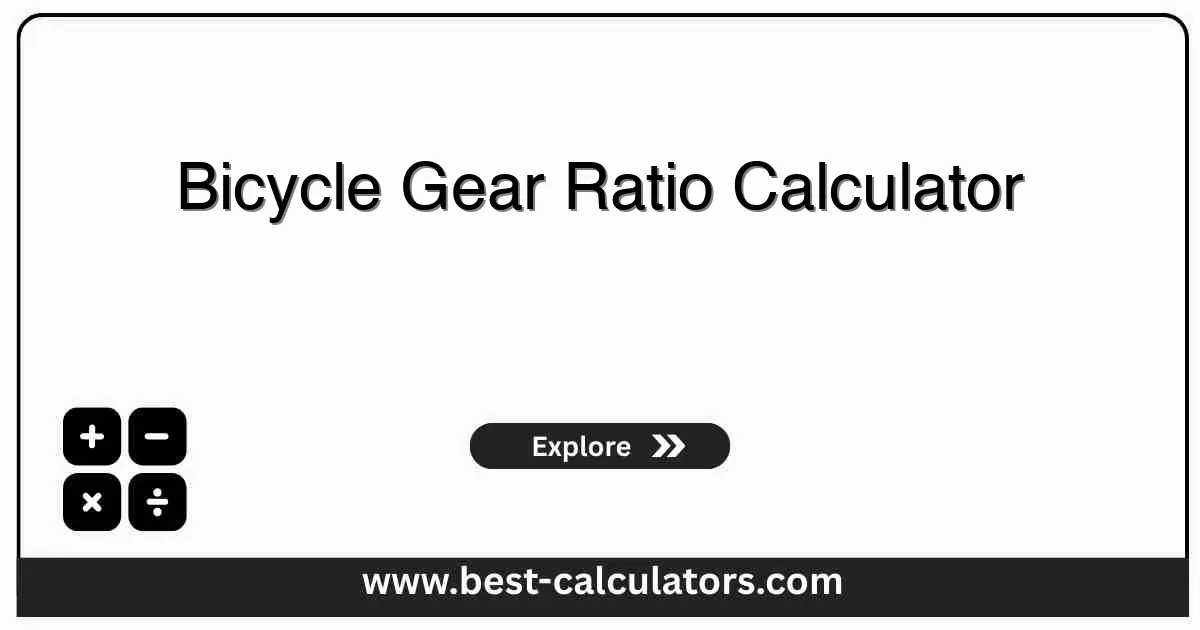Bicycle Gear Ratio Calculator - Calculate Gear Ratios, Speed & Gear Inches
Free calculator to determine bicycle gear ratios, gear inches, meters of development, and speed at different cadences for optimal bike setup and training.
Bicycle Gear Ratio Calculator
Results
What is a Bicycle Gear Ratio Calculator?
A Bicycle Gear Ratio Calculator is a free tool that helps cyclists understand their bike's gearing system. It calculates gear ratios, gear inches, meters of development, and speed at different cadences to help you optimize your bike setup for various riding conditions.
This calculator works for:
- Road cyclists - Optimize gear ratios for speed and efficiency
- Mountain bikers - Understand climbing and descending capabilities
- Triathletes - Fine-tune bike gearing for race performance
- Commuters - Find the right balance of speed and comfort
Related Tools:
Optimize your cycling performance by training at the right heart rate zones with our Target Heart Rate Calculator.
For triathletes, plan your bike-to-run transition with our Running Pace Calculator.
Build the leg strength needed for higher gear ratios with our One Rep Max Calculator.
How Bicycle Gear Ratio Calculator Works
The calculation uses standard bicycle gearing formulas:
Where:
- Front Teeth = Number of teeth on the front chainring
- Rear Teeth = Number of teeth on the rear cog
- Wheel Circumference = Distance traveled per wheel revolution
- Cadence = Pedaling speed in revolutions per minute
Key Concepts Explained
Gear Ratio
The mechanical advantage of your drivetrain. Higher ratios mean faster speeds.
Gear Inches
Equivalent wheel size that would give the same gearing effect.
Meters of Development
Distance traveled per pedal revolution in meters.
Cadence
How fast you pedal, measured in revolutions per minute (RPM).
Bike Type Gear Comparison
| Bike Type | Front | Rear | Ratio | Use Case |
|---|---|---|---|---|
| Road Racing | 50-53 | 11-28 | 1.8-4.8 | Speed on flats |
| Mountain XC | 32-36 | 10-50 | 0.6-3.6 | Steep climbs |
| Gravel | 46-48 | 11-42 | 1.1-4.4 | Mixed terrain |
| Touring | 48-50 | 11-36 | 1.3-4.5 | Loaded touring |
| Track Fixed | 48-52 | 14-17 | 2.8-3.7 | Velodrome |
How to Use This Calculator
Enter Chainring
Input the number of teeth on your front chainring (typically 50-53 for road bikes)
Enter Cog
Input the number of teeth on your rear cog (typically 11-28)
Select Wheel Size
Choose your wheel size or enter a custom measurement
Set Cadence
Enter your pedaling cadence in RPM
Get Results
View your gear ratio, speed, and gearing analysis
Benefits of Using This Calculator
- • Optimize gear selection - Choose the right chainring and cassette for your riding style
- • Understand speed potential - Know your top speed at different cadences
- • Training optimization - Select gears appropriate for your training goals
- • Compare bike setups - Evaluate different gearing configurations
Factors That Affect Your Gear Ratio
1. Terrain
Hills require lower gear ratios for climbing, while flat terrain allows higher ratios for speed
2. Fitness Level
Fitter cyclists can handle higher gear ratios and maintain faster speeds
3. Wind Conditions
Headwinds require lower gear ratios, while tailwinds allow higher ratios
4. Tire Pressure
Proper tire pressure affects rolling resistance and effective gear ratio

Frequently Asked Questions (FAQ)
Q: What is a bicycle gear ratio?
A: A bicycle gear ratio is the ratio between the number of teeth on the front chainring and the rear cog. It determines how much torque and speed you can achieve when pedaling. A higher ratio means more speed but less torque, while a lower ratio means more torque but less speed.
Q: What are gear inches?
A: Gear inches measure the equivalent diameter of a wheel that would give the same gearing effect as your current setup. It's calculated by multiplying the wheel circumference by the gear ratio. Higher gear inches mean higher top speed.
Q: How do I calculate bicycle speed from gear ratio?
A: Bicycle speed is calculated using the formula: Speed = (Cadence × Gear Ratio × Wheel Circumference × 60) / 1000000. You need your pedaling cadence (RPM), gear ratio, and wheel circumference to determine your speed in km/h.
Q: What wheel size should I enter?
A: Enter your wheel size in inches. Common sizes include: 26" for mountain bikes, 27.5" for hybrid bikes, 29" for larger mountain bikes, and 28" (700c) for road bikes. You can also measure your wheel diameter from the ground to the top of the tire.
Q: How does gear ratio affect my cycling?
A: Gear ratio affects both your speed and the effort required to pedal. A low gear ratio (small chainring, large cog) makes it easier to climb hills but slower on flat ground. A high gear ratio (large chainring, small cog) allows faster speeds on flat ground but requires more effort.
Q: What cadence should I aim for?
A: Most cyclists aim for a cadence between 80-100 RPM for efficient cycling. Lower cadences (60-80 RPM) are used for climbing or high-torque situations, while higher cadences (100+ RPM) are used for high-speed riding.